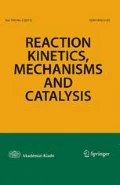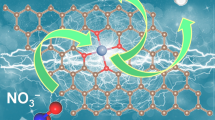Abstract
A set of CuO–V2O5/TiO2–carbon nanotubes catalysts were prepared by sol–gel method and the structural characteristics of the prepared catalyst were examined by scanning electron microscope, Fourier transform infrared spectroscopy, Brunauer–Emmett–Teller surface area measurements, X-ray diffraction, X-ray photoelectron spectroscopy and temperature programmed desorption (TPD) analyses. It was observed from the results that vanadium particles were highly dispersed on the CNTs wall and the promotional effects of CuO over V2O5/TiO2–CNTs catalyst were also investigated. The positivity of the catalytic activity was attributed to the diameter of the CNTs used. Among the catalysts, V–Cu1/Ti–C10 (1 wt% Cu & 10 wt% CNTs) with CNTs having an outer diameter of 10–15 nm attained a NOx removal efficiency of 94% at 300 °C under a gas hourly space velocity of 30,000 h−1. The existence of copper species in the form of small CuO clusters and Cu2+ ions in the catalyst enhanced the redox properties of the catalyst. The presence of CNTs improved catalytic activity and provides better resistance to SO2 and H2O at the low reaction temperatures.








Similar content being viewed by others
References
Mochida I, Korai Y, Shirahama M et al (2000) Removal of SOx and NOx over activated carbon fibers. Carbon N Y 38:227–239. https://doi.org/10.1016/S0008-6223(99)00179-7
Chmielewski AG, Sun Y, Zimek Z et al (2002) Mechanism of NOx removal by electron beam process in the presence of scavengers. Radiat Phys Chem 65:397–403. https://doi.org/10.1016/S0969-806X(02)00340-7
Choi B, Lee KS (2014) LNT/CDPF catalysts for simultaneous removal of NOx and PM from diesel vehicle exhaust. Chem Eng J 240:476–486. https://doi.org/10.1016/j.cej.2013.10.100
Simböck J, Khetan A, Pegios N et al (2019) Deactivation reactions on a commercial lean nox-trap—effect of hydrocarbon nature, concentration and operation temperature. Appl Catal A 585:117178. https://doi.org/10.1016/j.apcata.2019.117178
Sitshebo S, Tsolakis A, Theinnoi K (2009) Promoting hydrocarbon-SCR of NOx in diesel engine exhaust by hydrogen and fuel reforming. Int J Hydrog Energy 34:7842–7850. https://doi.org/10.1016/j.ijhydene.2009.07.059
Xiaoyan SHI, Yunbo YU, Hong HE et al (2008) Combination of biodiesel-ethanol-diesel fuel blend and SCR catalyst assembly to reduce emissions from a heavy-duty diesel engine. J Environ Sci 20:177–182. https://doi.org/10.1016/S1001-0742(08)60028-5
Seo CK, Kim H, Choi B et al (2011) De-NOx characteristics of a combined system of LNT and SCR catalysts according to hydrothermal aging and sulfur poisoning. Catal Today 164:507–514. https://doi.org/10.1016/j.cattod.2010.10.010
You R, Meng M, Zhang J et al (2019) A noble-metal-free SCR-LNT coupled catalytic system used for high-concentration NOx reduction under lean-burn condition. Catal Today 327:347–356. https://doi.org/10.1016/j.cattod.2018.03.022
Praveena V, Martin MLJ (2018) A review on various after treatment techniques to reduce NOx emissions in a CI engine. J Energy Inst 91:704–720. https://doi.org/10.1016/j.joei.2017.05.010
Pârvulescu VI, Grange P, Delmon B (1998) Catalytic removal of NO. Catal Today 46:233–316. https://doi.org/10.1016/S0920-5861(98)00399-X
Zhao K, Han W, Tang Z et al (2016) Investigation of coating technology and catalytic performance over monolithic V2O5–WO3/TiO2 catalyst for selective catalytic reduction of NOx with NH3. Colloids Surf A Physicochem Eng Asp 503:53–60. https://doi.org/10.1016/j.colsurfa.2016.05.014
Jiang B, Liu Y, Wu Z (2009) Low-temperature selective catalytic reduction of NO on MnOx/TiO2 prepared by different methods. J Hazard Mater 162:1249–1254. https://doi.org/10.1016/j.jhazmat.2008.06.013
Aguilar-Romero M, Camposeco R, Castillo S et al (2017) Acidity, surface species, and catalytic activity study on V2O5–WO3/TiO2 nanotube catalysts for selective NO reduction by NH3. Fuel 198:123–133. https://doi.org/10.1016/j.fuel.2016.11.090
Dunn JP, Koppula PR, Stenger HG, Wachs IE (1998) Oxidation of sulfur dioxide to sulfur trioxide over supported vanadia catalysts. Appl Catal B Environ 19:103–117. https://doi.org/10.1016/S0926-3373(98)00060-5
Dunn JP, Stenger HG, Wachs IE (1999) Oxidation of SO2 over supported metal oxide catalysts. J Catal 181:233–243
Wang Y, Wang F, Li G et al (2014) Mercury removal over the vanadia–titania catalyst in CO2-enriched conditions. Chem Eng J 263:356–363. https://doi.org/10.1016/j.cej.2014.10.091
Kim J, Gyu ÆT (2008) Heterogeneous mercury reaction on a selective catalytic reduction (SCR) catalyst. Catal Lett 121:219–225. https://doi.org/10.1007/s10562-007-9317-0
Jang BWL, Spivey JJ, Kung MC, Kung HH (1996) Low-temperature NOx removal for flue gas cleanup. ACS Div Fuel Chem Prep 41:308–311
Ma Z, Wu X, Feng Y et al (2015) Low-temperature SCR activity and SO2 deactivation mechanism of Ce-modified V2O5–WO3/TiO2 catalyst. Prog Nat Sci Mater Int 25:342–352. https://doi.org/10.1016/j.pnsc.2015.07.002
Li L, Sun B, Sun J et al (2017) Novel MnOx–CeO2 nanosphere catalyst for low-temperature NH3-SCR. Catal Commun 100:98–102. https://doi.org/10.1016/j.catcom.2017.06.019
Zhang Y, Zheng Y, Wang X, Lu X (2015) Preparation of Mn–FeOx/CNTs catalysts by redox co-precipitation and application in low-temperature NO reduction with NH3. CATCOM 62:57–61. https://doi.org/10.1016/j.catcom.2014.12.023
Zhang Y, Zheng Y, Zou H, Zhang X (2015) One-step synthesis of ternary MnO2–Fe2O3–CeO2–Ce2O3/CNT catalysts for use in low-temperature NO reduction with NH3. Catal Commun 71:46–50. https://doi.org/10.1016/j.catcom.2015.08.011
Huang B, Huang R, Jin D, Ye D (2007) Low temperature SCR of NO with NH3 over carbon nanotubes supported vanadium oxides. Catal Today 126:279–283. https://doi.org/10.1016/j.cattod.2007.06.002
Pourkhalil M, Moghaddam AZ, Rashidi A et al (2013) Preparation of highly active manganese oxides supported on functionalized MWNTs for low temperature NOx reduction with NH3. Appl Surf Sci. https://doi.org/10.1016/j.apsusc.2013.04.076
Wang X, Zheng Y, Xu Z et al (2014) Low-temperature NO reduction with NH3 over Mn–CeOx/CNT catalysts prepared by a liquid-phase method. Catal Sci Technol. https://doi.org/10.1039/c4cy00026a
Shen B, Chen J, Yue S, Li G (2015) A comparative study of modified cotton biochar and activated carbon based catalysts in low temperature SCR. Fuel 156:47–53. https://doi.org/10.1016/j.fuel.2015.04.027
Wen J, GuoQianqian HY, Guoqiang Ma, Han Xiaojin HZ (2014) Catalytic role of vanadium(V) sulfate on activated carbon for SO2 oxidation and NH3-SCR of NO at low temperatures. Catal Commun 56:23–26. https://doi.org/10.1016/j.catcom.2014.06.017
Rodriguez NM, Kim MS, Baker RTK (1994) Carbon nanofibers: a unique catalyst support medium. J Phys Chem 98:13108–13111. https://doi.org/10.1021/j100101a003
Chen C, Cao Y, Liu S et al (2018) SCR catalyst doped with copper for synergistic removal of slip ammonia and elemental mercury. Fuel Process Technol 181:268–278. https://doi.org/10.1016/j.fuproc.2018.09.025
Schwaemmle T, Heidel B, Brechtel K, Scheffknecht G (2012) Study of the effect of newly developed mercury oxidation catalysts on the DeNOx-activity and SO2–SO3-conversion. Fuel 101:179–186. https://doi.org/10.1016/j.fuel.2010.11.043
Li Q, Hou X, Yang H et al (2012) Promotional effect of CeOx for NO reduction over V2O5/TiO2—carbon nanotube composites. J Mol Catal A Chem 356:121–127. https://doi.org/10.1016/j.molcata.2012.01.004
Li Q, Yang H, Qiu F, Zhang X (2011) Promotional effects of carbon nanotubes on V2O5/TiO2 for NOx removal. J Hazard Mater 192:915–921. https://doi.org/10.1016/j.jhazmat.2011.05.101
Misra A, Tyagi PK, Singh MK, Misra DS (2006) FTIR studies of nitrogen doped carbon nanotubes. Diam Relat Mater 15:385–388. https://doi.org/10.1016/j.diamond.2005.08.013
Liu J, Shen M, Li C et al (2019) Enhanced hydrothermal stability of a manganese metavanadate catalyst based on WO3–TiO2 for the selective catalytic reduction of NOx with NH3. Reac Kinet Mech Cat 128:175–191. https://doi.org/10.1007/s11144-019-01624-7
Bai S, Jiang S, Li H, Guan Y (2015) Chinese Journal of Chemical Engineering Carbon nanotubes loaded with vanadium oxide for reduction NO with NH3 at low temperature. CJCHE 23:516–519. https://doi.org/10.1016/j.cjche.2014.07.003
Shi Y, Chen S, Sun H et al (2013) Low-temperature selective catalytic reduction of NOx with NH3 over hierarchically macro-mesoporous MnTiO2. Catal Commun 42:10–13. https://doi.org/10.1016/j.catcom.2013.07.036
Lu X, Song C, Jia S et al (2015) Low-temperature selective catalytic reduction of NOx with NH3 over cerium and manganese oxides supported on TiO2—graphene. Chem Eng J 260:776–784. https://doi.org/10.1016/j.cej.2014.09.058
Du X, Gao X, Fu Y et al (2012) The co-effect of Sb and Nb on the SCR performance of the V2O5/TiO2 catalyst. J Colloid Interface Sci 368:406–412. https://doi.org/10.1016/j.jcis.2011.11.026
Huang Z, Zhu Z, Liu Z (2002) Combined effect of H2O and SO2 on V2O5/AC catalysts for NO reduction with ammonia at lower temperatures. Appl Catal B Environ 39:361–368
Zhao X, Huang L, Li H et al (2015) Highly dispersed V2O5/TiO2 modified with transition metals (Cu, Fe, Mn Co) as efficient catalysts for the selective reduction of NO with NH3. Chin J Catal 36:1886–1899. https://doi.org/10.1016/S1872-2067(15)60958-5
Chen C, Jia W, Liu S, Cao Y (2018) The enhancement of CuO modified V2O5–WO3/TiO2 based SCR catalyst for Hg0 oxidation in simulated flue gas. Appl Surf Sci 436:1022–1029. https://doi.org/10.1016/j.apsusc.2017.12.123
Chen H, Qi X, Liang Y, Yang X (2019) Effect of Fe reduced—modification on—TiO2 supported Fe–Mn catalyst for NO removal by—NH3 at low temperature. Reac Kinet Mech Cat 126:327–339. https://doi.org/10.1007/s11144-018-1517-7
Xie C, Yang S, Wen J, Chunming S (2019) Constructing hollow silkworm structure in MnOx–TiO2 catalysts for improving the performance in selective catalytic reduction of NO by NH3. Reac Kinet Mech Cat 128:681–693. https://doi.org/10.1007/s11144-019-01669-8
Kang M, Duck E, Man J, Eui J (2007) Manganese oxide catalysts for NOx reduction with NH3 at low temperatures. Appl Catal A Gen 327:261–269. https://doi.org/10.1016/j.apcata.2007.05.024
Chen C, Jia W, Liu S, Cao Y (2018) Simultaneous NO removal and Hg0 oxidation over CuO doped V2O5–WO3/TiO2 catalyst in simulated coal-fired flue gas. Energy Fuels 32:7025–7034. https://doi.org/10.1021/acs.energyfuels.7b03905
Li H, Zhu L, Wu S et al (2016) Synergy of CuO and CeO2 combination for mercury oxidation under low-temperature selective catalytic reduction atmosphere. Int J Coal Geol 170:69–76. https://doi.org/10.1016/j.coal.2016.07.011
Li J, Tang X, Yi H et al (2017) Effects of copper-precursors on the catalytic activity of Cu/graphene catalysts for the selective catalytic oxidation of ammonia. Appl Surf Sci 412:37–44. https://doi.org/10.1016/j.apsusc.2017.03.227
Fleutot B, Martinez H, Pecquenard B et al (2008) Surface film morphology (AFM) and chemical features (XPS) of cycled V2O5 thin films in lithium microbatteries. J Power Sources 180:836–844. https://doi.org/10.1016/j.jpowsour.2008.02.080
Li Y, Zhong Q (2009) The characterization and activity of F-doped vanadia/titania for the selective catalytic reduction of NO with NH3 at low temperatures. J Hazard Mater 172:635–640. https://doi.org/10.1016/j.jhazmat.2009.07.039
Yu L, Zhong Q, Zhang S et al (2015) A CuO–V2O5/TiO2 catalyst for the selective catalytic reduction of NO with NH3. Combust Sci Technol 187:925–936. https://doi.org/10.1080/00102202.2014.993028
Zhao X, Huang L, Li H, Hu H, Han J, Shi L, Zhang D (2015) Highly dispersed V2O5/TiO2 modified with transition metals (Cu, Fe, Mn, Co) as efficient catalysts for the selective reduction of NO with NH3. Chin J Catal 36:1886–1899. https://doi.org/10.1016/S1872-2067(15)60958-5
Guan B, Lin H, Zhu L, Huang Z (2011) Selective catalytic reduction of NOx with NH3 over Mn, Ce substitution Ti0.9V0.1O2-δ nanocomposites catalysts prepared by self-propagating high-temperature synthesis method. J Phys Chem C 15:12850–12863
Tian W, Yang H, Fan X, Zhang X (2011) Catalytic reduction of NOx with NH3 over different-shaped MnO2 at low temperature. J Hazard Mater 188:105–109. https://doi.org/10.1016/j.jhazmat.2011.01.078
Author information
Authors and Affiliations
Corresponding author
Additional information
Publisher's Note
Springer Nature remains neutral with regard to jurisdictional claims in published maps and institutional affiliations.
Electronic supplementary material
Below is the link to the electronic supplementary material.
Rights and permissions
About this article
Cite this article
Raja, S., Alphin, M.S. Low temperature selective catalytic reduction of NOx by NH3 over Cu modified V2O5/TiO2–carbon nanotube catalyst. Reac Kinet Mech Cat 129, 787–804 (2020). https://doi.org/10.1007/s11144-020-01735-6
Received:
Accepted:
Published:
Issue Date:
DOI: https://doi.org/10.1007/s11144-020-01735-6




